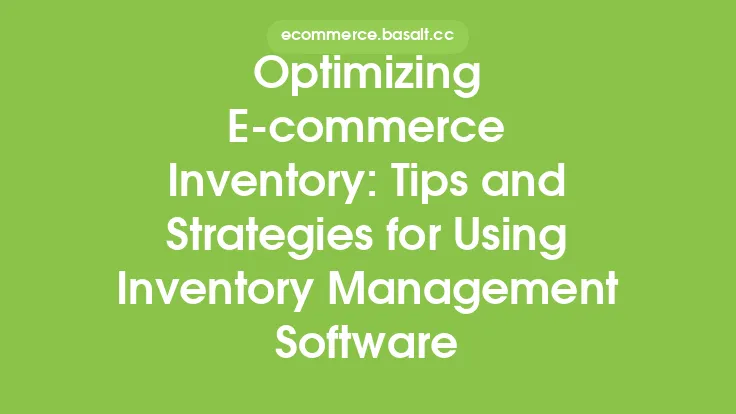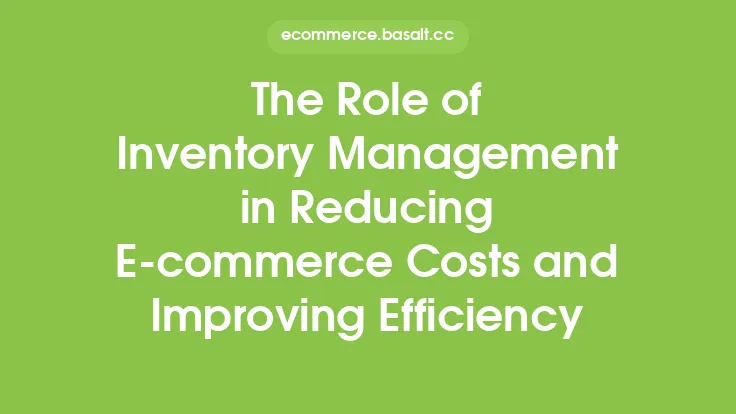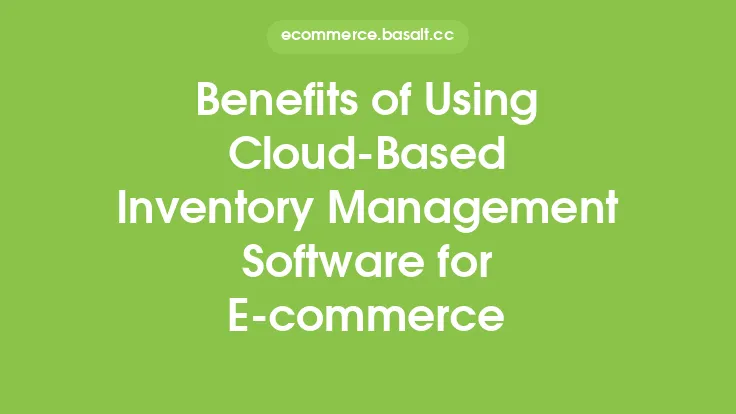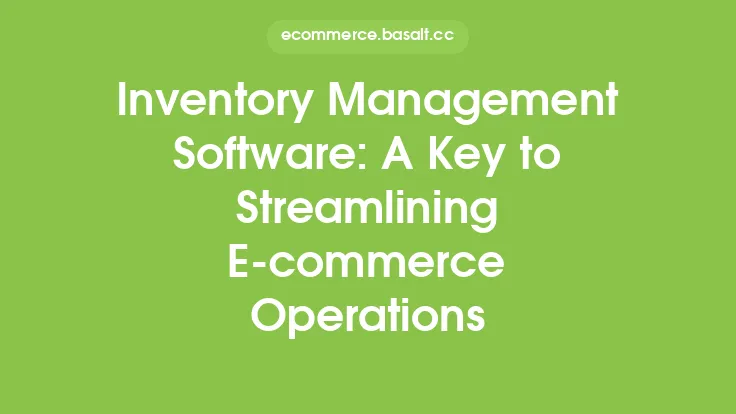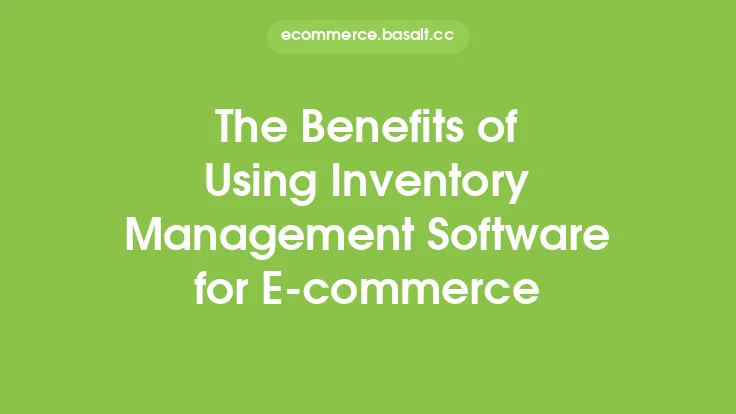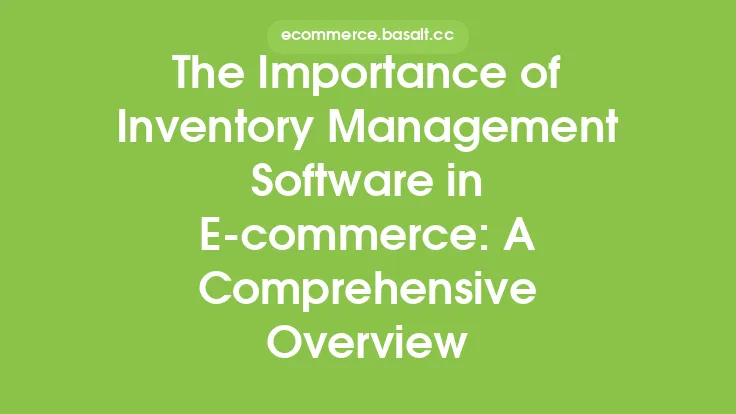Effective inventory management is crucial for e-commerce businesses to reduce costs and improve profitability. One of the most efficient ways to achieve this is by utilizing inventory management software. This software helps businesses to streamline their inventory processes, making it easier to manage stock levels, track orders, and prevent stockouts or overstocking. By implementing inventory management software, e-commerce businesses can significantly reduce their costs and improve their overall profitability.
Understanding Inventory Management Software
Inventory management software is a digital tool designed to help businesses manage their inventory levels, track stock movements, and optimize their supply chain operations. This software provides real-time visibility into inventory levels, allowing businesses to make informed decisions about stock replenishment, product pricing, and inventory allocation. With inventory management software, businesses can automate many manual tasks, such as tracking inventory levels, generating reports, and sending notifications when stock levels are low. This automation helps to reduce errors, increase efficiency, and free up staff to focus on more strategic tasks.
Key Benefits of Inventory Management Software
The key benefits of inventory management software include reduced inventory costs, improved inventory accuracy, and enhanced supply chain visibility. By using inventory management software, businesses can reduce their inventory costs by minimizing stockouts, overstocking, and dead stock. The software helps businesses to optimize their inventory levels, ensuring that they have the right products in stock to meet customer demand. This, in turn, helps to improve customer satisfaction, reduce lead times, and increase sales. Additionally, inventory management software provides real-time visibility into inventory levels, allowing businesses to respond quickly to changes in demand or supply chain disruptions.
How Inventory Management Software Reduces E-commerce Costs
Inventory management software reduces e-commerce costs in several ways. Firstly, it helps businesses to minimize stockouts and overstocking, which can result in significant losses. By optimizing inventory levels, businesses can reduce the need for expensive emergency shipments or stock replenishments. Secondly, inventory management software helps businesses to reduce waste and dead stock by identifying slow-moving or obsolete products. This enables businesses to clear out unwanted inventory, free up storage space, and reduce waste disposal costs. Thirdly, inventory management software automates many manual tasks, reducing labor costs and increasing productivity.
Improving Profitability with Inventory Management Software
Inventory management software can also help e-commerce businesses to improve their profitability. By optimizing inventory levels, businesses can increase their sales and revenue. The software helps businesses to identify fast-moving products, allowing them to stock up on popular items and maximize sales opportunities. Additionally, inventory management software provides real-time visibility into inventory levels, enabling businesses to respond quickly to changes in demand or supply chain disruptions. This helps businesses to minimize lost sales, reduce lead times, and improve customer satisfaction. By improving inventory management, businesses can also reduce their inventory costs, freeing up more resources to invest in marketing, product development, and other strategic initiatives.
Best Practices for Implementing Inventory Management Software
To get the most out of inventory management software, e-commerce businesses should follow best practices for implementation. Firstly, businesses should define their inventory management goals and objectives, such as reducing stockouts or improving inventory accuracy. Secondly, businesses should choose an inventory management software that meets their specific needs and requirements. This may involve evaluating different software options, reading reviews, and seeking recommendations from other businesses. Thirdly, businesses should ensure that their inventory management software is integrated with their e-commerce platform, accounting system, and other relevant systems. This helps to ensure seamless data exchange, automated workflows, and real-time visibility into inventory levels.
Common Challenges and Solutions
Despite the many benefits of inventory management software, e-commerce businesses may face common challenges during implementation. One of the most common challenges is data migration, which involves transferring existing inventory data into the new software system. To overcome this challenge, businesses should ensure that their inventory management software provides a simple and intuitive data import process. Another common challenge is user adoption, which involves training staff to use the new software system. To overcome this challenge, businesses should provide comprehensive training and support, including user manuals, video tutorials, and online support resources. By addressing these challenges, businesses can ensure a smooth and successful implementation of their inventory management software.
Future of Inventory Management Software
The future of inventory management software is exciting and rapidly evolving. With the advent of emerging technologies such as artificial intelligence, machine learning, and the Internet of Things (IoT), inventory management software is becoming increasingly sophisticated and automated. For example, some inventory management software systems now use AI-powered predictive analytics to forecast demand, optimize inventory levels, and identify potential stockouts or overstocking. Additionally, the use of IoT devices such as RFID tags and sensors is becoming more widespread, enabling businesses to track inventory levels and movements in real-time. As these technologies continue to evolve, we can expect to see even more innovative and effective inventory management software solutions in the future.
Conclusion
In conclusion, inventory management software is a powerful tool for e-commerce businesses to reduce costs and improve profitability. By streamlining inventory processes, automating manual tasks, and providing real-time visibility into inventory levels, inventory management software helps businesses to minimize stockouts, overstocking, and dead stock. By following best practices for implementation, addressing common challenges, and staying up-to-date with the latest technologies and trends, e-commerce businesses can maximize the benefits of inventory management software and achieve long-term success and profitability. Whether you are a small startup or a large enterprise, inventory management software is an essential investment for any e-commerce business looking to reduce costs, improve efficiency, and drive growth.
